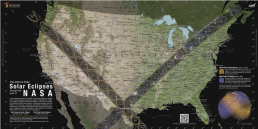Resources
Help monitor the effects of solar eclipses on wildlife in Central and South America with Sounds in the Darkness
Help monitor the effects of solar eclipses on wildlife in Central and South America with Sounds in the Darkness
January 19, 2024
DO NOW: Multi-sensory Eclipse Observations
DO NOW:
Multi-sensory Eclipse Observations
Created in collaboration with Tracey Kline, Lynn Public Schools, Lynn, MA
Grades 6-8, NGSS: MS-ESS1-1 Earth’s Place in the Universe
Instructions
- Watch both videos
- Use what you learn from both videos to brainstorm answers to the questions below.
- Discuss your answers with a partner, or as a class.
Video 2
What do Animals do During a Solar Eclipse?
Link: https://bit.ly/animals_during_eclipses
Length: 1:16


Answer these questions In your notebook or on a piece of paper:
1. How would you observe animals or your environment during a solar eclipse using all of your senses?
-
- What would you listen for?
- What would you look for?
- What would you try to feel/touch
2. Recording the information you gather during your observations is important. How or where are you going to record your information?
Wrap-up: Discuss answers and ideas with a partner and/or as a class.
Do Now Resources
- “Multi-sensory Observing Do Now” Google Slides (2 options): When you open this link you will be prompted to make a copy of the Google slides. This will allow you to edit either of these slide options to best meet the needs of your classroom.
- “Multisensory Observing Do Now” Handout (Google Doc): When you open this link you will be prompted to make a copy of the Google document. This will allow you to edit the Google document to best meet the needs of your classroom. [Students will need to use a mobile device with this handout to watch videos.]
- Technology Modification Option: If students do not have ipads, chromebooks, mobile devices etc, videos can be played to the whole class from the website and then followed by the brainstorm activity in their notebooks.








